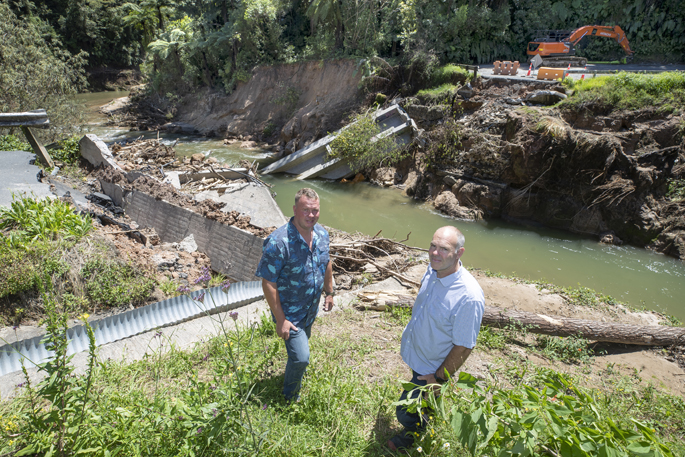Residents of a rural road in Te Puke are worried the location of a replacement bridge won’t be suitable for the large trucks needed to haul kiwifruit, logs and livestock.
Severe weather washed out the original bridge over the Raparapahoe Stream on No 4 Road in January 2023.
A temporary Bailey bridge opened in March 2023.
In December, Western Bay of Plenty district councillors endorsed a new $2.75 million, 30m single-lane bridge, which will be located 5-10m upstream of the former bridge.
Known as Option 1, the bridge’s construction is subject to the appropriate alignment being achieved to enable trucks to cross safely.
However, residents raised concerns about this option at a meeting with council in October and proposed another solution.
The group suggested the Bailey bridge be moved upstream, then the permanent bridge be built in the same place as the former bridge (Option 5).
Orchardist George Muir says he worried moving the bridge closer to the S-bend on the western side of the stream would make it harder for trucks.
“If it's too close between the two corners, then the big rigs might not be able to get around because it's quite hard even as it is.
“We think that by moving the bridge closer to the corner it’s going to make it even harder.”
 George Muir, right, and his brother Ben at the site of the bridge washout. Photo: John Borren/SunLive
George Muir, right, and his brother Ben at the site of the bridge washout. Photo: John Borren/SunLive
The Muir family have around 40 hectares of kiwifruit on their No 4 Road properties.
Muir says the residents asked council staff to investigate the alignment and cost of their suggestion before decisions were made by council, but this didn’t occur.
During December’s meeting, Te Puke-Maketu ward councillor Grant Dally said he was “flummoxed” that there was no costing for the option presented by residents, or an answer to the alignment issues they raised.
“Surely there must be a way to do a quick analysis to actually determine these things [the road and bridge alignment] based on a quick geometrical check.”
Council senior transportation engineer Calum McLean replied they could investigate that option further but it would impact the programme of delivery for the bridge.
The next stage of the project is to find a consultant for a specimen design which would show if the option chosen was viable, he said.
Council hadn’t done an assessment into the cost of Option 5, but McLean said he did not believe it was the cheaper option.
It would also cause disruption and the road to be closed while the Bailey bridge was relocated, he said.
Access is available through a private road, but McLean said it was unlikely the owners would allow it to be used because they opposed a previous request when the bridge needed maintenance.
 The four options for the new bridge on No 4 Road. Photo: WBOPDC.
The four options for the new bridge on No 4 Road. Photo: WBOPDC.
Local Democracy Reporting asked McLean if the council had investigated the alignment of the proposed new bridge or costed Option 5.
He replied: “The next phase of the project is to engage a contractor to undertake design and construction of the new bridge.
“As part of that process a design will be produced to confirm that Option 1 can be implemented. If Option 1 is found to be unfeasible, council will choose an alternative option.
“We are confident that the option chosen by council can be successfully delivered. The new bridge and approach will be designed to safely accommodate the largest vehicle likely to use the bridge, a 23m long 50MAX logging truck.
Option 5 was considered unacceptable because it required the road to be temporarily closed without a detour for residents, McLean says.
“Option 1 made the most sense, in terms of cost, design and minimising disruption. We were particularly mindful of the kiwifruit season, and providing a solution that would keep things moving during this busy time.”
A contractor will be found during the next two to three months, and council expects the design to be completed in six to seven months’ time, he says.
The council will apply for a subsidy from New Zealand Transport Agency Waka Kotahi for the majority of the cost.
LDR is local body journalism co-funded by RNZ and NZ On Air.




0 comments
Leave a Comment
You must be logged in to make a comment.